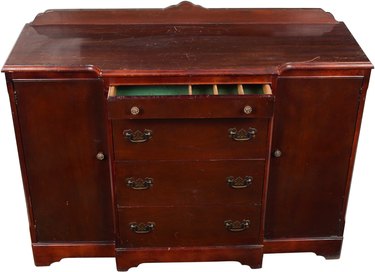Things You'll Need
Electric hand sander
Sander pads
Sandpaper
Wood stain
Polyurethane

Water is often the cause of damage to wood furniture. The wood swells and creates a raised area, which will need to be sanded down so that it's flush with the rest of the surface. The repair job will take at least a few hours to complete and another day for materials to dry. You don't need a lot of woodworking experience -- just the ability to sand and stain wood.
Step 1
Place the furniture piece in a suitable work area. If you can work on the furniture outside, this is ideal, since you will have a lot of dust as well as odor from the stain and polyurethane. If you can't do the job outside, place the furniture in an area where there's good ventilation.
Video of the Day
Step 2
Sand down the raised area. Use an electric hand sander at first, with a medium-grade sanding pad. To avoid gouging the wood, start the sander running in the air and slowly lower it onto the wood. This will give you more control. Make several passes and lightly sand down the area until it's flush with the rest of the wood.
Step 3
Hand sand the damaged area. Use a fine grade of sandpaper, and sand down the area until it feels smooth to the touch. Feather the sanding marks out a little from the patch so that you can blend in your fix.
Step 4
Re-stain the wood. Use the same wood stain as on the rest of the piece, and cover over the patched area. Use as many coats as needed to match the depth of color on the rest of the piece, and lightly sand in between coats. Sand one more time before applying the polyurethane.
Step 5
Clear coat the fix. Use a clear polyurethane to seal the wood and protect it. One coat should be sufficient, but if you decide to do two, sand lightly before applying the second coat.
Video of the Day